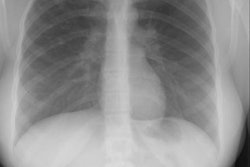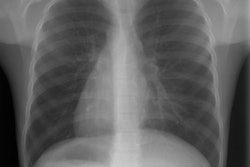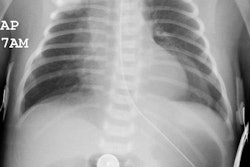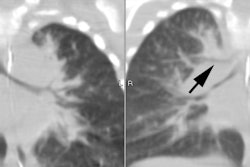Cystic Adenomatoid Malformation (Congenital pulmonary airway
malformation):
View
cases of cystic adenomatoid malformation
Clinical:
CCAM
(CPAM) is the most commonly diagnosed lung malformation in prenatal patients
and accounts for 30-40% of all congenital diseases [7]. However, overall CAM is
a rare lesion that is felt to result from failure of the respiratory or mesenchymal portion of the lung to canalize and join the
bronchial or endodermal portion. Many consider it a hamartoma characterized by disorganized overgrowth of the
terminal respiratory structures, modified by intercommunicating cysts. There
are microscopic tubular malformations lined by cuboidal
epithelium admixed with broad bands of smooth muscle and mucinous
cells. The blood supply and venous drainage is via the pulmonary system (there
is no systemic arterial supply in CCAM) [8]. The CCAM may communicate with the
proximal airways, although the airways within the mass are poorly developed
[8].
The
lesion typically presents in the neonate period (75%) often due to respiratory
distress and cyanosis. Uncommonly, the lesion may present after months to years
as about 10% of affected patients are asymptomatic. Approximately 50% of
affected infants are born premature and 15% are stillborn. Associated
abnormalities such as renal dysgenesis, congenital
heart disease, foregut malformations, bronchogenic
cyst, and skeletal malformations have been reported in 1.5-15% of cases [8]. Chomosomal abnormalities (trisomy
13,18, or 21) have also been reported [8].
?CAM is almost always unilateral, involving a
single lobe, with an upper lobe or no lobar predominance [2]. Treatment is
surgical even in asymptomatic infants to prevent infection and due to the low,
but potential risk of developing rhabdomyosarcoma
within the lesion [2]. In asymptomatic patients, surgery can be performed
between 2-9 months of age [9]. Prenatal resection of a CCAM can also be
performed and may result in improved survival in fetuses that develop hydrops
[3]. Some antenatally diagnosed lesions (4-15%) may
regress within the first year of life [9].
A newer classification system is based upon the histopathologic findings and consists of 5 types of CCAM's [7]. However, there are 3 main types of CCAM identified at imaging, although mixed lesions, consisting of types 1 and 2, have also been described. Most CCAMs derive their blood supply from the pulmonary artery and drain via the pulmonary veins, however, hybrid lesions can have a systemic arterial supply [7].
- Type I: This is the most common form (50-70%) and it has the best prognosis. Typically there are multiple large intercommunicating or a single dominant cyst (over 2.0 cm in size). The cysts are lined by ciliated columnar epithelium and their walls contain abundant elastic tissue [5]. The CXR findings can resemble congenital lobar emphysema.
- Type 2: This is the next most common (20-40%) and consists of multiple small cysts (under 1.2-2 cm) and a mixture of solid tissue [9]. The cysts are lined with cuboidal or columar epithelium and are said to resemble dilated bronchioles [5]. Unfortunately, this form is commonly associated with other, usually lethal, congenital anomalies (especially renal agenesis). Extralobar pulmonary sequestrations are reported to coexist with CAM type II in up to 50% of cases [5].
- Type 3: This form is rare (up to 10% of cases [2]) and is characterized by dilated bronchial-like structures that appear as a large, solid, space occupying mass. The cysts are microscopic in size (rarely larger than 0.2 cm in diameter [6]) and not apparent radiographically. The cysts are lined by cuboidal epithelium [5]. This sub-type is associated with a poor prognosis secondary to pulmonary hypoplasia.
Differential considerations include: Congenital lobar emphysema, bronchogenic cyst, bronchopulmonary sequestration, prior infection with pneumatocele formation, and diaphragmatic hernia. A low grade cystic pleura-pulmonary blastoma is also radiographicslly indistinguishable from a CCAM [9].
X-ray:
Fetal US: On US, there is an anechoic structure within the lung, although the lesion can also appear echogenic [8]. Other findings on prenatal US include: polyhydramnios (2/3's), fetal hydrops (20%), and ascites (70%) which is a result of venous obstruction by the cystic/solid intrathoracic mass (the normal fetal lung has a homogeneous moderately hyperechoic appearance). All of these later findings are poor prognostic indicators- especially hydrops which is a harbinger of impending fetal death [3].
CXR: On CXR, initially the lesion appears as an intrapulmonary water density mass with well defined margins which may or may not contain lucent cystic areas (these areas will fill with air [from collateral drift via the pores of Kohn or via communication with the bronchial tree] over time as the fluid drains). After the neonatal period, a CCAM typically appears as a unilateral air-filled multicystic lesion [9]. Air-fluid levels may be identified within the cysts. If large the lesion will displace the heart and mediastinum to the opposite side. The lesions can also have changing appearances over time due to retained fluid secretions or superinfection.
Computed tomography: CT findings include small or large cysts- the cysts may be air filled, fluid-filled, or contain air fluid levels. Other findings include areas of consolidation with heterogeneous attenuation on enhanced scans, areas of low attenuation around the cystic lesions (due to the presence of microcysts blended with normal lung parenchyma), and soft tissue components to the lesion. Unlike bronchopulmonary sequestrations, CCAM communicates with the tracheobronchial tree and has an arterial blood supply and venous drainage from the pulmonary circulation [6].
MRI: On fetal MR, type I lesions usually manifest as hyperintense uni- or multilocular regions with discrete walls on T2-weighted images [6]. Type II lesions have variable appearances depending on the composition of the malformation [6]. Type III lesions manifest as homogenenously hyperintense solid masses with normal adjacent parenchyma [6].
REFERENCES:
(2) AJR 1999; Donnelly LF, et al. Localized radiolucent chest lesions in neonates. Causes and differentiation. 172: 1651-1658
(3) Radiology 1999; Hubbard AM, et al. Congenital chest lesions: Diagnosis and characterization with prenatal MR imaging. 212: 43-48
(4) Radiographics 2002; Zylak CF. Developmental lung anomalies in the adult: radiologic-pathologic correlation. 22: S25-S43
(5) Radiol Clin N Am 2005; Paterson A. Imaging evaluation of congenital lung abnormalities in infants and children. 43: 303-323
(6) Radiographics 2010; Daltro P, et al. Congenital chest malformations: a multimodality approach with emphasis on fetal MR imaging. 30: 385-395
(7) Radiographics 2010; Biyyam DR, et al. Congenital lung abnormalities: embryologic features, prenatal diagnosis, and post natal radiologic-pathologic correlation. 30: 1721-1738
(8) Radiographics 2011; Dighe MK, et al. EXIT procedure: technique and indications with prenatal imaging parameters for assessment of airway patency. 31: 511-526
(9) Radiographics 2011; AIRP best cases in radiologic-pathologic correlation. Type 2 congenital cystic adenomatoid malformation (type 2 congenital pulmonary airway malformation). Kao SW, et al. 31: 743-748



